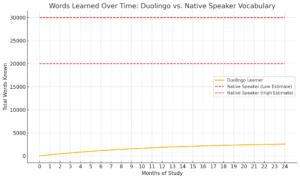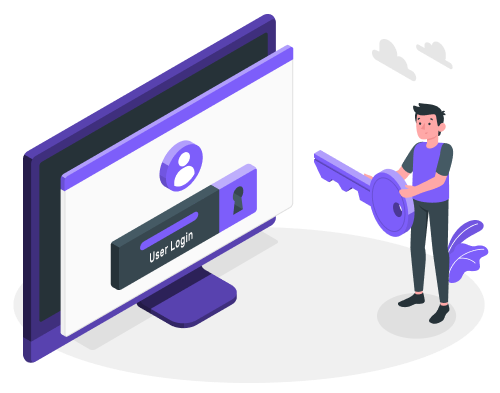Just interested in English resources and practical activities?
How to learn English?
Welcome to Refold’s 2025 English quickstart guide!
If you want to speak English fluently, you’ve come to the right place—no matter whether you’re a complete beginner or a seasoned veteran.
By the time you’ve finished reading this guide you will know…
- Why you’ve struggled with traditional language learning methods.
- How to build an instinct for language so you can stop translating and speak fluently and naturally.
- The secret to conquering motivation once and for all.
- The core activities and resources you need for each phase of your language learning journey—from zero all the way to fluency and beyond.
Why trust Refold?
Refold is two things: a language learning company and a community of language learners.
We began in 2020 as a small community of passionate language learners who believed that anyone can learn a language with the right approach. Since then, our community has grown to over 50,000 language learners and includes learners from all over the world. Join us and say hi!
As a company, our mission is to ensure every language learner achieves their goals. Our free guides, courses, coaching, and vocabulary decks have helped tens of thousands of learners reach fluency. Our hands-on experience working with coaching clients and our community gives us unique insight into where learners get stuck—and what actually helps them move forward.
And we can help you too! Think of us as your personal trainer for language learning—here to help you overcome any obstacle you face and make huge language learning gains.
The language learning industry is broken
Despite the fact that billions of people set out to reach fluency in a foreign language, few adult learners manage to reach this goal.
This leads learners to wonder…
- Am I too old to learn a language?
- Do I need to have a language-learning “talent” to reach fluency?
- Why do other people seem to know what they’re doing, but I feel clueless?
Let us assure you:
- You are NOT too old to learn a language! We have many older members in our community who reached fluency regardless of their age!
- You don’t need any “talent” to reach fluency! Several members of our core team have ZERO talent and still reached fluency just fine.
- You are not alone in your struggles! Success stories simply tend to go viral because of the nature of the internet. The vast majority of language learners don’t really know how to make progress, but the algorithm won’t show you their stories in your YouTube or TikTok feed.
The traditional approach won’t get you to fluency
Most learners are familiar with what we call the traditional approach to language learning.
You memorize grammar rules and words, and then you combine them to translate from your native language into your target language — kind of like a language-based math problem. The assumption is that if you practice translation enough, it will eventually become automatic and you can stop translating — resulting in fluent speech.
Unfortunately, very few learners ever reach that automaticity.
Benefits 😄
- You’re able to have limited conversations almost immediately.
- Textbooks, tutors, and classrooms provide external structure and accountability.
- Can be fun for extroverts who aren’t afraid of making tons of mistakes.
Drawbacks ☹️
- Speaking doesn’t become fluent or automatic for most people. They never stop needing to translate in their head.
- Some people manage to reach automaticity but their abilities are extremely limited and rigid: they only have automaticity in set phrases and very frequent conversational patterns.
- Translation is a mentally intensive process (like doing math problems in your head) that causes you to burn out very quickly.
- You struggle to understand what your conversation partner is saying. They have to dumb their speech down so much that they feel as frustrated as you do.
You need to build an instinct for language!
So how do you overcome the drawbacks of the traditional approach?
Since the early 80s, second language researchers have discovered one fact, over and over: humans learn languages through input, not translation. You get input by reading and listening to the language.
Humans are naturals at learning languages in this way because our brains are pattern-matching machines that excel at mimicking the language of our peers. As you get more and more exposure to the language, your brain will subconsciously build a model of the language’s patterns. When you’ve built up a complete language model, you’ll be able to feel what sounds right and what sounds wrong on an instinctual level — allowing you to speak naturally and automatically, just like you already do in your native language.
Benefits 🙂
- You’ll speak fluently and naturally.
- There’s no translation necessary.
- It’s less mentally intensive; you’ll avoid fatigue and burnout.
- The majority of the process can be done alone from the comfort of your own home.
- You don’t need textbooks or tutors. You can turn TV shows or books into your study material.
Drawbacks ☹️
- It takes a long time to build a solid instinct. There are no shortcuts to reaching fluency.
- Learning mostly by yourself can be lonely, especially if you are an extrovert. We recommend an activity called crosstalk to help with this.
- The lack of tutors and classrooms means you need to provide your own structure and accountability — though you can incorporate tutors and classes into the instinct-building approach too.
How to build an instinct: Understand before speaking
Your goal in the instinct-building approach is to imitate natural speakers (to sound as fluent and natural as they do). But here’s the catch: you can’t imitate what you don’t yet understand. As a beginner, native speakers sound like incomprehensible noise.
This is why we take a counterintuitive approach: we delay speaking to focus on understanding first. Once you can understand native speakers, imitating them becomes much easier.
How to understand a language: Use comprehensible input
To build your internal model of the language, you need to consume language that you can at least partially comprehend. We call this comprehensible input.
If you can’t understand your reading or listening input at all, your brain will have nothing to latch on to and won’t be able to identify any patterns (it would be like trying to understand white noise or figure out a crossword puzzle with no clues).
Although partially understanding input is enough, it’s more efficient if you mostly understand it, as your brain will have an easier time with pattern identification. But as a beginner, you’ll have a hard time mostly understanding anything, so here’s what we recommend:
- Find input that’s comprehensible by default thanks to visual context. When you can look at pictures and gestures while the speaker is talking, it’s possible to understand what they’re trying to say even when you don’t know any or most of the words or grammar involved. We recommend resources like this in the Activities & Resources section below.
- Make your input more comprehensible with preparation and techniques. Here are some example techniques:
- Study words or grammar, and then, try to notice them while reading or listening.
- Read the plot of a TV show episode before watching it (or simply watch a TV show you’ve seen before in your native language since you’ll already know the plot well).
- Use a popup dictionary to quickly look up the meanings of unknown words in your reading.
As your comprehension grows, you’ll find that you need to rely on these support tactics less and less, and then eventually — you’ll understand native speakers with no help at all.
Reaching fluency takes more time than you think!
It’s important to have the right expectations so you can plan accordingly.
Native speakers know 20,000-30,000 words, but apps like Duolingo only teach you 2,000 words — and they design their apps to keep you using them and paying them for YEARS. This means that when you’ve hit your 500-day Duolingo streak you won’t even be close to fluency.

For conversational fluency, you’ll need 5,000 words you can actively use in conversation and 10,000 that you can passively understand. This is a big goal that takes lots of time — typically several years of studying one or two hours every day.
The key question becomes: How do you stick with this long term to rack up all the time you need?
Relying on motivation is a recipe for DISASTER!
Most people rely on motivation to keep their language learning going, but motivation comes and goes — you cannot completely control it. Learners who rely on motivation end up burning out very early on in the process.
The solution isn’t to endlessly chase motivation! You need a personal learning system.
Here’s how to make reaching fluency inevitable
The key to avoiding motivation burnout is to build systems that keep on working even when you don’t feel like learning.
There are four key things to focus on when building your personal learning system:
Make learning automatic with habits
Instead of relying on motivation, build strong habits that keep you moving forward. Habits are behaviors you’ve repeated so many times they become automatic — like waking up, taking a shower, or brushing your teeth. You don’t need motivation or willpower to do them. Build strong habits by prioritizing consistency before intensity: begin studying for a smaller amount of time each day and slowly increase it after you’ve consistently reached your goal for a while.
Struggling to stay consistent? Learn how to build consistency with our course: Build Habits That Stick.
I’m ready to build habits that stick
Make learning fun
If you focus on activities that are more enjoyable for you, you won’t need to rely on willpower or motivation to do them. Don’t feel pressured to do the “most optimal” approach if it isn’t enjoyable for you. Lots of learners spend too much time and energy trying to optimize everything. In reality, the most important thing is just that you show up every day. If you aren’t having fun and you stop showing up, you’ll never reach your goal.
Keep yourself honest
A lot of people overestimate where they’re spending their time. When they first try tracking their time they are almost always surprised to discover how much time they waste each day.
Time and habit tracking force you to be honest with yourself and better understand your behavior patterns so that you can make the necessary adjustments that keep you on track.
We designed and built a free time and habit-tracking app specifically for language learners. Level up your learning today!
Get the FREE app

Get help from others
Surround yourself with other language learners who will push you to do the thing every day.
Join the English community now
If you need more support, consider getting help from our coaches to keep you on track.

Struggling with language learning?
Eliminate any doubts
Get your questions answered and learn what tools and strategies are most effective for you.
Create a detailed action plan
Wake up every morning knowing exactly what you need to do and how you’re going to get it done.
Rekindle your love for language learning
Discover the activities that are the most fun and effective FOR YOU.


Okay, that’s enough theory. Let’s move on to the practical activities and resources that you’ll need for each phase of the learning process.
Resources & Activities
Phase 1: Foundation
Overview
- Goal: Basic reading comprehension
- Hours: It takes about 75 hours to go through this phase, and you’ll have 75 total hours after you complete it. ()
- Core activities:
- Phonetic writing system
- Vocab Study
- Basic grammar
- Immersion
Phonetic writing system
Connect the written language to the proper sounds of the language. Refold reading decks were made exactly for this purpose, but you can also watch videos about the phonetic writing system and practice reading it during your immersion.
English Resources
Vocab Study
Use a premade anki flashcard deck or app to study the 2,000 most common root words.
How to learn vocab with anki as an adult video
Cognate hacking is a great technique that can speed up the process for learning languages related to ones you already know.
Basic grammar
Read about basic grammar principles necessary for comprehension. Don’t worry about trying to produce the language yet (via grammar drills or similar exercises).
Immersion
Find simplified content (content made for language learners) that has subtitles and audio, then, play the noticing game with it. You can watch our tutorial for an overview of this process.
The noticing game is when you look for words you’ve learned via flashcards/apps in your immersion. Using subtitles is preferred, but you can go without. You can optionally use a metalayer and popup dictionary extension to look up words in the subtitles after you’ve noticed them.

Feeling overwhelmed by language learning?
Become confident
Build your personalized daily learning routine – unlock clarity of exactly what activities to do every day
Stop wasting time
Lifetime access to 25+ language Resource Database – So you don’t need to struggle with finding the right resources
No more overwhelm
Lifetime access to Refold coaching support so you never get stuck again


Phase 2: Reading
Overview
- Goal: Effortless reading comprehension for casual conversation (subtitled)
- Hours: It takes about 375 hours to go through this phase, and you’ll have 450 total hours after you complete it. ()
- Core Activities:
- Intensive 3-channel reading
- Freeflow 3-channel reading
- Sentence Mining and Review
- Grammar Priming
Intensive 3-channel reading
Read the subtitles of media content that has a visual, audio, and text component. Turn on autopause. Read every subtitle line along with the audio. Then try to understand the sentence. If there are zero, one, or two unknown words in the sentence, look them up. Then, try to understand the sentence again. If there are three or more unknown words, just continue to the next sentence.
English Resources
Suggested Youtube Channels: Pokémon and Kurzgesagt
Click here for instructions on how to set up Pokémon.
Freeflow 3-channel reading
Read the subtitles of media content that has a visual, audio, and text component. Don’t use autopause or look up words. Optionally, you can omit the visual and/or audio component, but you will find that Phase 3 (Listening) is easier if you don’t.
Sentence Mining and Review
As you immerse in content, find sentences with vocabulary or grammar that you don’t know (preferably just one unknown per sentence) and create flashcards from them. Study these flashcards at a later time. You can learn about different sentence-mining card formats here.
Sentence mining tutorial video
For sentence mining tooling, a popular tool is the Yomitan Browser Extension, which can integrate directly with Anki and create new flashcards with just one click.
Grammar
Read about basic grammar principles necessary for comprehension. Don’t worry about trying to produce the language yet (via grammar drills or similar exercises). You can also lookup unknown grammar principles you find in the wild — AI is an excellent aid in the case where you aren’t sure exactly what grammar principle you’ve stumbled upon.
English Resources
Phase 3: Listening
Overview
- Goal: Effortless listening comprehension for casual conversation
- Hours: It takes about 300 hours to go through this phase, and you’ll have 750 total hours after you complete it. ()
- Core Activities:
- Freeflow listening
- Intensive Listening
- Crosstalk
- Subvocal chorusing
Freeflow listening
In this phase, freeflow listening is the most important activity and you will spend most of your time on it. Listen to audio without doing any lookups or pausing. This could be a TV show, podcast, or audiobook, but you’ll find that sticking to conversational content or content you’ve already done intensive listening with is the easiest.
Intensive Listening
Intensive listening is very similar to intensive 3-channel reading, except instead of reading each subtitle line right away, you listen to it up to three times before reading the subtitle line to confirm your understanding.
Crosstalk
Chorusing
Listen and repeat words and short phrases. Unlike shadowing where you continue without pausing, you should make extensive use of looping the audio to practice the language in small sections at a time. You need to walk before you can run! This activity is in Phase 3: Listening because it helps develop a finer ear for harder-to-hear sounds that you may have been missing or ignoring until now.
Advanced techniques for chorusing include recording yourself for later speaking analysis.
Struggling to understand native speakers?
Learn 10 proven techniques to unlock effortless listening
Never struggle to find content
Get curated listening resources for 25+ languages plus tools like minimal pairs decks to sharpen your ear
Get unstuck fast
Experienced coaches help you pinpoint your exact listening challenges and fast-track your progress


Phase 4: Speaking
Overview
- Goal: Speaking comfort
- Hours: It takes about 150 hours to go through this phase, and you’ll have 900 total hours after you complete it. ()
- Core Activities:
- Speaking with natives
- Monologuing (Recorded)
- Chorusing
- Freeflow Listening
Speaking With Natives
Most of what you should be doing in this phase is talking in your target language with native speakers of that language. You can either have conversations in real-time or asynchronously with voice memos. Don’t stress about outputting perfectly in this phase, just try to develop fluidity with expressing your thoughts.
Hellotalk and Tandem are the most popular apps to find native speakers to chat with.
Monologuing
Talk to yourself in your target language. You can talk to yourself anywhere, but it’s best if you record it so you can watch it later and review for errors. Basic monologuing involves talking to yourself about any topic. Advanced techniques include “reaction speaking,” where you watch content and pause frequently to summarize what you just watched in your own words, or share your thoughts about the content.
Techniques:
- Embody your “dumber persona”
- Reaction speaking
- Storytelling
- Journaling out loud
Chorusing
Listen and repeat words and and short phrases. Unlike shadowing where you continue without pausing, you should make extensive use of looping the audio to practice the language in small section at a time. You need to walk before you can run!
Advanced techniques for chorusing include recording yourself for later speaking analysis.
Freeflow Listening
Listen to audio without pausing, looking at any text, or looking up words.
Phase 5: Writing
Overview
- Goal: Correct output
- Hours: It takes about 225 hours to go through this phase, and you’ll have 1125 total hours after you complete it. ()
- Core Activities:
- Corrected writing
- Freeflow writing
- Speaking or texting with natives
- Freeflow Reading
Corrected Writing
Corrected writing is the act of reviewing a piece of content you have already written during a freeflow writing activity. You can use AI tools and human feedback to edit and revise your writing. This is the most important activity in this phase since the goal of phase 5 is to iron out as many imperfections in your output as you can.
How to get the most out of your tutors tutorial video
Journaly is a popular app where you can get corrections on your journaling entries
Freeflow Writing
It’s not enough to just do corrected writing, you need to get the hours in and simply write a lot! Copywork is a great way to internalize correct ways of writing, but with freeflow writing you’ll spend most of your time writing your own stuff, whether thats reacting to youtube videos, journaling, blogging, writing a story, or any other thing you like to write about.
Freeflow Reading
Read without stopping to look-up words (with or without audio).
Speaking/Texting With Natives
Writing a journal entry or blog post is one thing, but casual texting is an entirely different beast. Find some language exchange partners and have some fun texting with them! Speaking will be useful in this phase as well to activate your newly corrected output patterns from writing.
Hellotalk and Tandem are the most popular apps to find native speakers to text with.
Phase 6: Fluency
Overview
- Goal: Effortless output
- Hours: It takes about 225 hours to go through this phase, and you’ll have 1350 total hours after you complete it. ()
- Core Activities:
- Speaking or texting with natives (and incorporate group conversations/activities)
- Freeflow writing
- Shadowing
- Freeflow reading or listening
Speaking/Texting With Natives
Shadowing
Listen to audio (without pausing) and repeat after the speaker. Your speech will essentially be 1-3 seconds behind the speaker you are shadowing. If you fall behind, simply take a breather and then begin shadowing again from wherever the native speaker is currently at.
English Resources
Freeflow Writing
It’s not enough to just do corrected writing, you need to get the hours in and simply write a lot! Copywork is a great way to internalize correct ways of writing, but with freeflow writing you’ll spend most of your time writing your own stuff, whether thats reacting to youtube videos, journaling, blogging, writing a story, or any other thing you like to write about.
Freeflow Reading or Listening
You’ll get the most bang for your buck reading and listening to the conversational domain, assuming this is the domain you are trying to develop effortless output in first. However, at the stage you are totally capable of expanding into more specialized or niche domains, such as science videos or fantasy books.
English Resources
Phase 7: Beyond
Overview
- Goal: Expansion of all abilities until you reach your personal fluency goal
- Hours: Language learning is a never ending journey; there’s always more to learn!
- Core Activities:
- Start a youtube channel or podcast in the language
- Write essays, articles, or in-depth blog posts
- C2 (or equivalent) Exam Preparation
- Freeflow reading or listening (with harder materials and new domains)
Start a YouTube Channel or Podcast in the Language
Once you’re comfortable speaking and writing, start creating long-form content on social media in your target language. This helps you put everything you’ve learned into practice and connect with native speakers. Hint: Create content about a topic you’re interested in, so you can make friends with native speakers who share the same interest!
Write Essays, Articles, or In-depth Blog Posts
Writing well takes practice, even for native speakers. To get better at writing in your target language, pick a topic and write a full essay, article, or blog post about it, just like you would for a school or professional assignment.
C2 (or equivalent) Exam Preparation
Learn about the requirements to pass the highest level of proficiency test for your target language and then work on your abilities until you are reasonably confident you can pass it. Make good use of any available practice tests or well-regarded guidebooks. If it’s not too costly, feel free to take the test even if you aren’t completely ready yet, just to give yourself a solid feel for what the test is like and what you need to be capable of.
English Resources
Freeflow reading or listening (with harder materials and new domains)
Now that you’ve mastered the conversational domain, it’s time to push your abilities to new levels by using much harder resources and expanding into new domains.

Feeling overwhelmed by language learning?
Become confident
Build your personalized daily learning routine – unlock clarity of exactly what activities to do every day
Stop wasting time
Lifetime access to 25+ language Resource Database – So you don’t need to struggle with finding the right resources
No more overwhelm
Lifetime access to Refold coaching support so you never get stuck again







